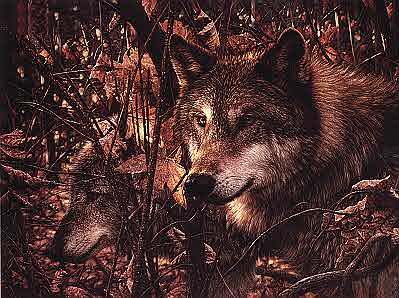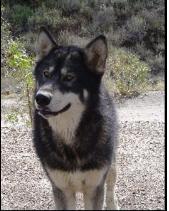 |
|
Info on Acclimating Wolves |

Acclimating Wolves
This is close to the same as From Gray to Red wolves, but there are some differences.
You know that gray wolves are at Yellowstone and the red are at Alligator River and the Great Smokys.
There are two techniques use to reintroduce wolves to the wild, and they are called (1)Soft release, (2) Hard release.
In a hard release the wolf is taken to the reintroduction area in a crate and simply let go.
In a soft release the wolf is put in an acclimation pen at the release site for several weeks
to several months. On the day it is to be reintroduced, the wolf is "released" by leaving the gate open.
It's free to leave the pen whenever it wants.
At Yellowstone th gray wolves are fed road-kill elk and deer. The red wolves at Alligator River are fed road-killed deer, opossum, raccoon, nutria, squirrel, and rabbit.
If you are wondering what an acclimation pen lookes like, I'll tell you.... Acclimation pens have panels of heavy-gauge chain-link fencing. And the fence is 8 feet tall wiht an overhang to prevent the wolves from jumping out. Inside the pen there is a "digging barrier" to stop the wolves from digging their way to freedom before they have completed their acclimation. The pens at Alligator River and the Great Smokys are 50 x 50 feet. The pens at Yellowstone for the gray wolves are nearly an acre in size.

A thing for people to remember is that wolves have a natural fear of humans, so don't believe that the wolf will attack you if it see's you, because it will normally run away.
Biologists visit the pens a couple times a week to deliver the food and chech on the wolves . A few days before they are released the wolves are caught and given their final physical examination by the veterinarian. They are weighed, inoculated against disease, and if needed, equipped with new radio collars.
Some history about the life of wolves: One hundred and fifty years ago the wolf was found in great numbers throughout North America. It wasn't unusual to see wolves loping over the Great Plains , dashing through vast forests, or vanishing into the thick bushed and grass growing along rivers. Captain Meriwether Lewis, of the Lewis and Clark expedition, wrote that the wolves prowling around the edges of immense buffalo herds were so common that they reminded him of the sheepdogs he'd seen in West Virginia herding domestic livestock.
Some people ask where did all the wolves go, if they were so abundent back then?
When people arrived here in America they brought mare than there things with them. They
also brought the bab idea that wolves would kill all the domestic livestock and wild game
that the people depended on. In addition to this, they also believed that wolves preyed on humans.
The truth about wolves is that they are rarely aggressive towards people. In
the USA, there has never been a documented case of a wild wolf killing a human being. In the
presence of people, wolves are actually timid and shy.

WOLVES ARE NOT BAD OR EVIL, they are simply predators attempting to survive in the only
way they know how. Like us, they try to get their food in the easiest and safest way possible. And
at times, this means they will kill domestic livestock, but this is not as common as many people think.
People's fear of wolves started a war that eliminated wolves from most of the USA. Wolves were shot,
poisoned, and trapped. Wolves are easily killed. One reason is because wolves form pack and are
territorial, meaning that when a wolf pack finds a suitable habitat it generally stays in that area. Both
the red and the gray wolves are listed as endangered species. This means they are very rare and in danger
of becoming extinct.
We earlier learned that wolves play an important role in helping to balance our natural ecosystems. As a top
predator, wolves kill sick and injured animals. (Fact of the page: wolves and people can live together!)
Both red and gray wolves are making a come back in the USA with the help of the USA!
Grya wolves have been reintroduced into Yellowstone National Park in Montana and Wyoming after an absence of over 60 years.
Red wolves have been reintroduced into the Alligator River National Wildlife Refuge
In North Carolina, the Great Smoky Mountains National Parkm and several small islands in the
southeastern US after nearly 100 years.
